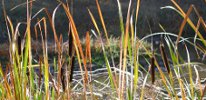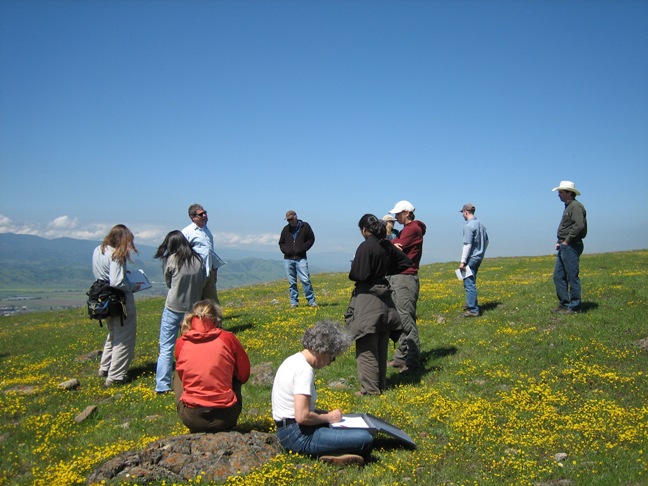
Training
Coyote Ridge Serpentine Field Trip 2006

COST: FREE
REGISTRATION FOR THIS PROGRAM IS CLOSED
Instructor Information
Stuart Weiss
Consulting Ecologist
Creekside Center fo Earth Observations
Contact
Grey Hayes
grey@elkhornslough.org
(831) 274-8700
Sponsors
Description
See also: Serpentine Grasslands, Maintaining Biodiversity
On April 13, 2006, 22 researchers, regulators, land stewards, and consultants met on Coyote Ridge to discuss the conservation of the Bay Area's serpentine grasslands. Dr. Stuart Weiss led the discussion, informing the audience of his many years of research into Nitrogen deposition, grazing, and Bay checkerspot butterfly conservation. Participants first viewed a fenceline which divided grazed and ungrazed portions of the serpentine grassland. Where it has not been grazed, vegetation was dominated by Italian ryegrass. Where cattle grazing (Dec - June) takes place, there was an abrubt shift to diverse native wildflowers and grasses. Stuart told us that the site was impacted by around 12-15 lbs/acre of Nitrogen deposition each year, around 20% of typical agricultural application. Because the serpentine grasslands have been scientifically demonstrated to be Nitrogen limited, additional Nitrogen spurs the growth of weedy grasses that outcompete native plants. As we progessed uphill towards Coyote Ridge, we made several stops to look at species that are narrowly distributed on nearby serpentine soils. We first viewed the rare Mt. Hamilton thistle (Cirsium fontinale var. campylon), which grows in sunny wet areas. We then viewed disjunct populations of otherwise Mojavean plants, such as Monolopia sp and Chaenactis sp. Finally, we found a population of the Santa Clara Valley Duddleya (D. setchelli), a federally-listed Endangered species. Once on the ridge, we began our real discussion of the impacts of Nitrogen deposition by hearing in depth life history information on the Bay checkerspot butterfly. The species primarily eats annual plantain plants, which are highly sensitive to drying. The variety of slopes and aspects on Coyote Ridge helps maintain the butterfly's host plant years of varying rainfall and heat. But, the short annual plantain is also threatened by the taller, more nitrogen loving non-native grasses, which are spurred to grow from the large amounts of Nitrogen being deposited from air pollution. Cattle grazing can mitigate the impacts of the non-native grasses, and help the Bay checkerspot to survive. We also spoke about the impacts of habitat fragmentation compounded by Nitrogen deposition: the checkerspot has now disappeared from Edgewood County Park and Jasper Ridge. We ended the field trip at a fenceline dividing the growing season grazing from later-season grazing. The landscape-level heterogeneity of these varied grazing regimes appears to benefit the Bay checkerspot, as well. In some years, the butterfly is more abundant in the later season vs. the earlier season pastures. Dr. Bartolome then spoke to us about research into the preferences of grassland birds. Grasshopper sparrows, horned larks, meadowlarks, and savannah sparrows are grassland dependent birds in California. Some preliminary research suggests that grasshopper sparrows are never found in areas that are not grazed, and horned larks are almost always found in grazed areas whereas meadowlarks and savannah sparrows don't seem to have a preference for grazed or ungrazed grasslands. On two occassions during the field trip, participants were able to view the area's elk herd, which is now frequently found near the cattle on Coyote Ridge. We also saw golden eagles. After many weeks of daily rain, the group enjoyed a sunny beautiful, warm day. We look forward to continuing our dialogue, networking experts, and following the research as it unfolds.
Documents and Publications
| DOCUMENT | AUTHOR / SOURCE |
|---|---|
| WORKSHOP MATERIALS | |
| Attendees: Coyote Ridge Serpentine Field Trip 2006 PDF, 9KB |
Elkhorn Slough CTP |
Questions and Answers
Submit a question on this subject and we'll provide an answer. coastaltraining@elkhornsloughctp.org
